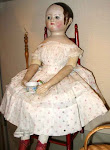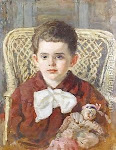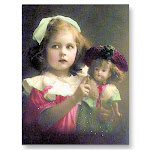(Ferriani in Bamboleide)
 "Jane Anne Campbell" by Ammi Phillips ca.1820
"Jane Anne Campbell" by Ammi Phillips ca.1820
 These miniature women with whom the young child had such close contact with, were a powerful influence. Girls were obliged to grow quickly and to adapt to the image the doll projected, something they did not naturally relate to.
These miniature women with whom the young child had such close contact with, were a powerful influence. Girls were obliged to grow quickly and to adapt to the image the doll projected, something they did not naturally relate to. "Mary Jane Smith" by Joseph Whiting ca. 1838
"Mary Jane Smith" by Joseph Whiting ca. 1838

Classic 9" Milliner's Model, suitable for a large scale dollhouse. Original presentation with molded hairstyle. Pink tulle dress with yellow-painted slippers.

Surrounded by an adult world the child performed actions in play with the doll that imitated those carried out by the mother of the child. She dressed her doll with care for the events of the day and chose suitable accessories from gloves to fans.

These Milliner's Model dolls represent the style of the times for young girls. In the 1830's it was fashionable to wear long white pantaloons or "pantalents" which very often showed beneath the hems of the little girls' dresses.

Portrait of a Victorian child holding a Milliner's Model type doll featuring the young "Queen Victoria" hairstyle, with the braids coiling around, and exposing the ears. This style was popular during the mid 1830's.
 Beautiful doll with child like appearance, ca. 1840- Long curls reaching to shoulders (as worn by girls in period 1840-1860,) featuring glass eyes and slightly opened mouth.
Beautiful doll with child like appearance, ca. 1840- Long curls reaching to shoulders (as worn by girls in period 1840-1860,) featuring glass eyes and slightly opened mouth.From the Rosemann Collection, Heissisches Puppenmuseum.

Though the rigours of the social whirl have left no trace of fatigue on the faces of these dolls, their clothes and hair bear the signs of repeated dressing and undressing, adjustments and re-adjustments….Marco Tosa “Classic Dolls”
 "Raymond Children" by Robert Peckham, 1838
"Raymond Children" by Robert Peckham, 1838Many early nineteenth-century paintings show children holding such dolls. There may have been actual milliner's models before the toy doll of that name came into use, but we do not know how close the resemblance between the two may have been. (This post is #1 of three on Milliner's Model Dolls)













































.jpg)




































































Such stunning portraits of these amazing dolls and their young owners..eye candy, each and every one! Thanks for the post, wonderful!
ReplyDeletesiempre es un placer pasar por aqui!!!! las muñecas antiguas me encantan, de hecho tengo algunas , pero no tan antiguas como las de las fotos, besos
ReplyDeleteMuchas gracias por el comentario tan amable.
ReplyDeleteDe por si esas muñecas son preciosas, ni el tiempo les quita su belleza.
Besos
Marta
Thank you Robin for your kind comments..It's so nice to hear from you!
ReplyDeleteBig Hugs
Marta
Hola Marta. Es curioso pensar que estas preciosas Milliner's dolls eran las Barbies de la época. La función, al final era la misma.
ReplyDelete¿La muñeca de 1837 es de tu colección? Es increíble plantearse lo que habrá "vivido" y a quién habrá pertenecido. ¿No? Es lo que siempre pienso de las antiguedades. Resulta fascinante para mí.
Muy bonito, Marta. Como siemre.
Un beso.
Muchas gracias Alberto.
ReplyDeleteEstas son mis muñecas favoritas, tengo la suerte de tener dos. Y una de ellas tiene una dedicatoria escrita en el cuerpo con la fecha 1840. Si pudieran hablar...que historias contarian!
Besos
Marta
Marta I love your blog! You have such a knowledge! Love love love looking at all the great pics. Definitely will be checking in to see what new things you'll be writing about.
ReplyDeleteUm what was it you said about having Bostons? giggle.
Ohh!! I'm so glad you visited..Thank you so much for your kind comments and for following my blog! I left you a comment regarding "Bostons".. A favorite breed,right up there with Papillons...
ReplyDeleteLove your blog! I'll be there often as well.
Thank you again Carol
Hugs
Marta
Hi Marta. Thank you so much for inviting me to your new blog. It is wonderful. I love the dolls.
ReplyDeletePan x
http://smallstuffdolls.blogspot.com/
Thank you Pan...delighted that you visited!
ReplyDeleteI am very excited about this blog. Antique dolls are my passion and its so rewarding to write about something you love, and have others inspire you to go on.
Thank you so much!
Hugs
Marta
Marta, thank you for the beautiful post!
ReplyDeleteI loved the most the first painting and the doll in Faerie Costume is exquisite!
I have a milliner model with a bun, and a tailored suit type blue top with linen cloth skirt. She has brown eyes and a bun. Can you tell me her age? And is the eye color more desirable either blue or brown. I have always admired this type doll, and have a few in my collection. Thank you. Roberta
ReplyDeleteHi Roberta...The earliest Milliners that prevailed are from around the 19th century, and early 20th. By the description of your doll's attire I would guess she must be early 20th century. The earlier ones I have seen are usually dressed on the Victorian fashion. These dolls go back to the time of Marie Antoinette , and were known a Pandoras, and they would be the models for the fashions in style in France and shipped through out Europe. Those however are only found in museums. As far as the eye color , mine are brown eyed, but I've seen both brown and blue. I think the brown eyes were more common at the time. I have other posts prior to this one, that covers some of the earlier dolls, you might find them interesting as well.
ReplyDeleteThank you for your comment and I hope I was able to help you.